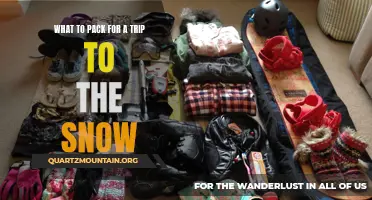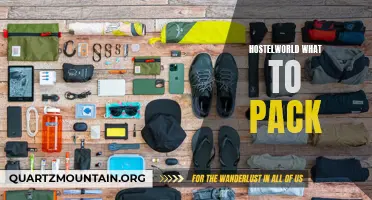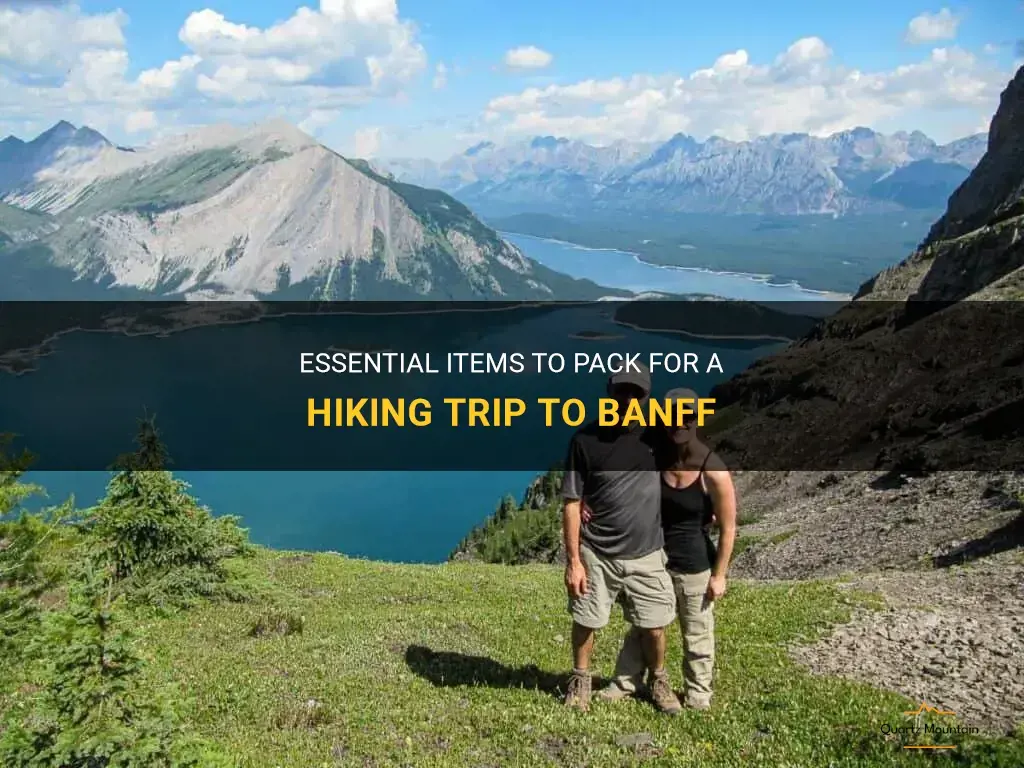
Are you planning a hiking trip to Banff? If so, you're in for a treat! Banff National Park is known for its breathtaking landscapes and incredible hiking trails. But before you embark on your adventure, it's important to make sure you're well prepared. In this article, we'll discuss the essential items you need to pack for your hiking trip to Banff, so you can have a safe and enjoyable experience. From proper footwear to navigation tools and first aid kits, we've got you covered. So, grab your backpack and let's get started on this epic journey!
| Characteristic | Value |
|---|---|
| Weather | Variable |
| Clothing | Layered |
| Footwear | Hiking boots |
| Backpack | Lightweight |
| Navigation | Map/Compass |
| Food and Water | Snacks, water |
| Shelter | Tent |
| Sleeping Gear | Sleeping bag |
| First Aid Kit | Essentials |
| Emergency Gear | Whistle, light |
| Protection | Sunscreen, hat |
| Communication | Cellphone |
| Tools | Multi-tool |
| Entertainment | Book, cards |
What You'll Learn
- What are the essential items to pack for a hiking trip to Banff?
- Are there any specific clothing items or gear that are necessary for hiking in Banff?
- What kind of footwear should I bring for hiking in Banff?
- Are there any safety or emergency items that are recommended for a hiking trip to Banff?
- Are there any specific considerations or restrictions on what can be packed for a hiking trip to Banff?

What are the essential items to pack for a hiking trip to Banff?
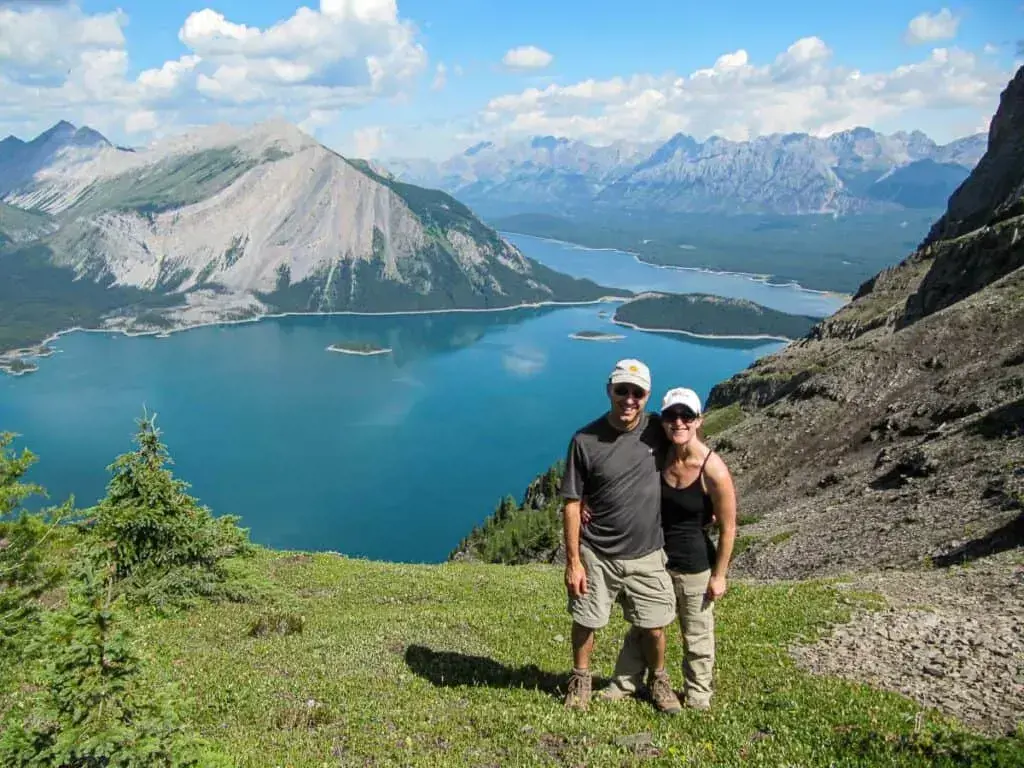
When heading out on a hiking trip to Banff, it is important to pack the essential items to ensure a safe and enjoyable experience. Banff National Park is known for its stunning scenery and diverse terrain, but it also presents some unique challenges for hikers. Here are the essential items to pack for a hiking trip to Banff:
- Proper hiking footwear: A sturdy pair of hiking boots with good ankle support is essential for navigating the rugged terrain of Banff. Look for boots that are waterproof and have a good grip to handle the various trails and conditions that you may encounter.
- Layered clothing: Banff's weather can be unpredictable, even in the summer months. It is important to pack layers so that you can adjust your clothing as needed. Start with a moisture-wicking base layer, add a lightweight insulating layer, and top it off with a waterproof and windproof outer layer. Don't forget to pack a hat, gloves, and extra socks as well.
- Navigation tools: Banff's trails can be extensive and sometimes poorly marked. It is essential to have a good map and a compass to help navigate your way through the park. Consider also bringing a GPS device or a smartphone with a navigation app to help you stay on track.
- Adequate food and water: It is important to stay hydrated and fuel your body during a hiking trip. Pack plenty of water and bring along a water filtration system if you plan on refilling your bottles from natural sources. Bring lightweight, non-perishable foods that are high in energy, such as trail mix, energy bars, and dried fruits.
- First aid kit and emergency supplies: Accidents can happen while hiking, so it is crucial to have a first aid kit on hand. Make sure your kit includes basic supplies such as bandages, antiseptic ointment, tweezers, and pain relievers. Additionally, pack a whistle, flashlight, fire starter, and a lightweight emergency blanket in case of unforeseen emergencies.
- Insect repellent and sunscreen: Banff is home to various insects, including mosquitoes, so it is important to pack insect repellent to protect yourself from bug bites. Additionally, the high elevation and thin atmosphere in Banff can intensify the sun's rays, so don't forget to pack sunscreen with a high SPF to protect your skin from sunburn.
- Proper backpack and gear: A comfortable and well-fitted backpack is essential for carrying all of your gear. Look for a backpack with padded shoulder straps and a waist belt to help distribute the weight evenly. Make sure it is large enough to accommodate all of your essential items, but not so large that it becomes cumbersome.
- Leave no trace essentials: When hiking in Banff, it is important to practice leave no trace principles to help preserve the park's natural beauty. Pack essentials such as biodegradable toilet paper, plastic bags for garbage, and eco-friendly soap for washing dishes. Always remember to leave the trail as you found it and respect the environment.
By packing these essential items, you will be well-prepared for a hiking trip to Banff. Remember to check the weather forecast, familiarize yourself with the trail conditions, and let someone know your itinerary before heading out. Enjoy the breathtaking scenery and unforgettable experiences that Banff National Park has to offer.
Essential Packing Tips for a July Trip to Europe
You may want to see also

Are there any specific clothing items or gear that are necessary for hiking in Banff?
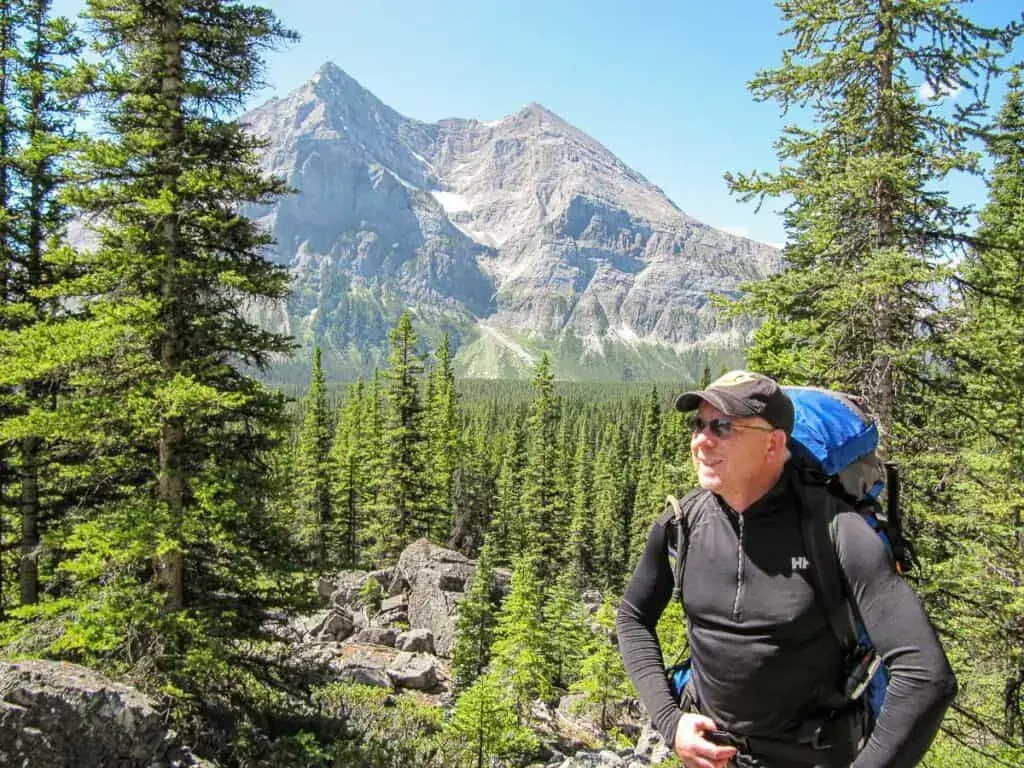
Hiking in Banff National Park is a wonderful way to experience the beauty of the Canadian Rockies, but it's important to come prepared with the right clothing and gear. The weather in the park can be unpredictable, and conditions can change quickly, so it's crucial to have the right clothing and gear to stay comfortable and safe on your hike.
One of the most important things to consider when hiking in Banff is the weather. The park experiences a wide range of conditions, from hot and sunny summer days to cold and snowy winter weather. It's essential to check the weather forecast before your hike and dress accordingly.
In general, it's a good idea to dress in layers when hiking in Banff. This allows you to adjust your clothing as the temperature changes throughout the day. Start with a moisture-wicking base layer, such as a lightweight synthetic or wool shirt. This will help keep you dry and comfortable by wicking sweat away from your skin.
On top of your base layer, add a lightweight insulating layer, such as a fleece or down jacket. This will provide an extra layer of warmth in colder temperatures. For colder weather or higher elevations, consider adding a waterproof and breathable outer layer, such as a Gore-Tex jacket. This will protect you from rain, snow, and wind while still allowing moisture to escape.
In terms of bottoms, choose a pair of comfortable and moisture-wicking pants or shorts, depending on the weather and personal preference. If you'll be hiking in cooler temperatures, consider wearing a pair of lightweight leggings or thermal pants under your pants or shorts for added warmth.
When it comes to footwear, it's important to wear shoes or boots that are comfortable and provide good traction. Hiking boots are often recommended for hiking in Banff, as they provide ankle support and protection. Make sure your footwear is broken in and fits well before your hike to avoid discomfort and blisters.
In addition to clothing, there are a few essential pieces of gear that you should bring with you on your hike in Banff. A backpack is essential for carrying your belongings, such as extra layers, food, water, and first aid supplies. Look for a backpack with a hydration system or pockets for water bottles to ensure you stay hydrated on the trail.
Other important gear includes a hat to protect you from the sun, sunglasses to protect your eyes, and sunscreen to protect your skin from harmful UV rays. It's also a good idea to bring a map, compass, or GPS device to help you navigate the trails in Banff.
Lastly, don't forget to pack some snacks and plenty of water for your hike. Staying hydrated and nourished is essential for your safety and enjoyment on the trail.
In conclusion, when hiking in Banff, it's important to come prepared with the right clothing and gear. Dress in layers, wear comfortable and moisture-wicking clothing, and choose footwear that provides traction and support. Bring a backpack to carry your essentials, and don't forget to pack a hat, sunglasses, sunscreen, and navigational tools. With the right clothing and gear, you'll be able to fully enjoy the beauty of Banff National Park while staying safe and comfortable on the trails.
Essential Items to Include in Your Desert Packing List
You may want to see also

What kind of footwear should I bring for hiking in Banff?
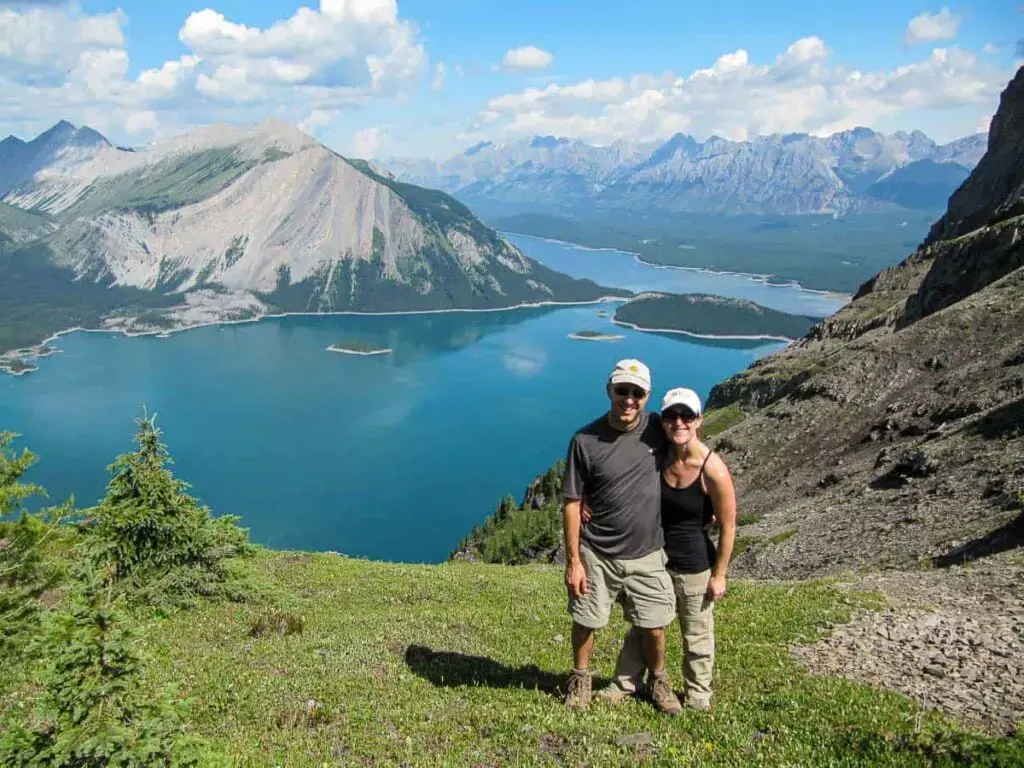
If you're planning a hiking trip in Banff, you'll want to make sure you have the right footwear to keep you comfortable and safe on the trails. The mountainous terrain and varying trail conditions in Banff National Park mean that you'll need footwear that is sturdy, supportive, and suitable for hiking in different weather conditions. Here's a guide to help you choose the right kind of footwear for hiking in Banff.
- Consider the trail difficulty: Banff offers a range of hiking trails, from easy walks to challenging climbs. Determine the difficulty level of the trails you plan to hike, and choose footwear that matches. For easy walks on well-groomed trails, lightweight hiking shoes or trail runners may be sufficient. However, for more challenging trails with uneven terrain and steep ascents, you'll want to opt for sturdy hiking boots that provide ankle support and protection.
- Look for good traction: The trails in Banff can be rocky, muddy, or even snowy, depending on the season. It's important to choose footwear with good traction to prevent slips and falls. Look for hiking shoes or boots with deep lugs on the soles, as these will provide better grip on uneven and slippery surfaces. Vibram soles are known for their excellent traction and durability, so consider footwear with this type of sole.
- Consider waterproofing: Banff's mountainous landscape means that you may encounter water crossings, streams, or even rain during your hike. To keep your feet dry and comfortable, consider wearing waterproof or water-resistant footwear. Waterproof hiking boots are a great option for hiking in Banff, as they will keep your feet dry even in wet conditions. If you prefer hiking shoes, consider treating them with a waterproofing spray to repel water.
- Ensure proper fit and comfort: One of the most important factors when choosing hiking footwear is ensuring a proper fit. Ill-fitting shoes can lead to blisters, discomfort, and even injuries. Visit a specialty outdoor store to get fitted for hiking footwear, as the staff can help you find the perfect fit. Make sure there's enough room in the toe box to prevent toe squishing on steep descents, and that the shoe or boot provides ample arch and ankle support.
- Break them in: Before embarking on a long hike in Banff, make sure to break in your new footwear. Wear them on shorter hikes or around town to allow the shoes or boots to mold to your feet and prevent uncomfortable rubbing or blisters. Breaking in your footwear will also give you a better idea of how they perform on different terrains and in various weather conditions.
In conclusion, when selecting footwear for hiking in Banff, consider the trail difficulty, traction, waterproofing, fit, and comfort. Choose hiking shoes or boots that are suitable for the specific terrain and weather conditions you'll encounter. By investing in the right footwear, you'll be able to fully enjoy the stunning beauty of Banff National Park while keeping your feet safe and comfortable.
Essential Packing List for a Memorable April Trip to Israel
You may want to see also

Are there any safety or emergency items that are recommended for a hiking trip to Banff?
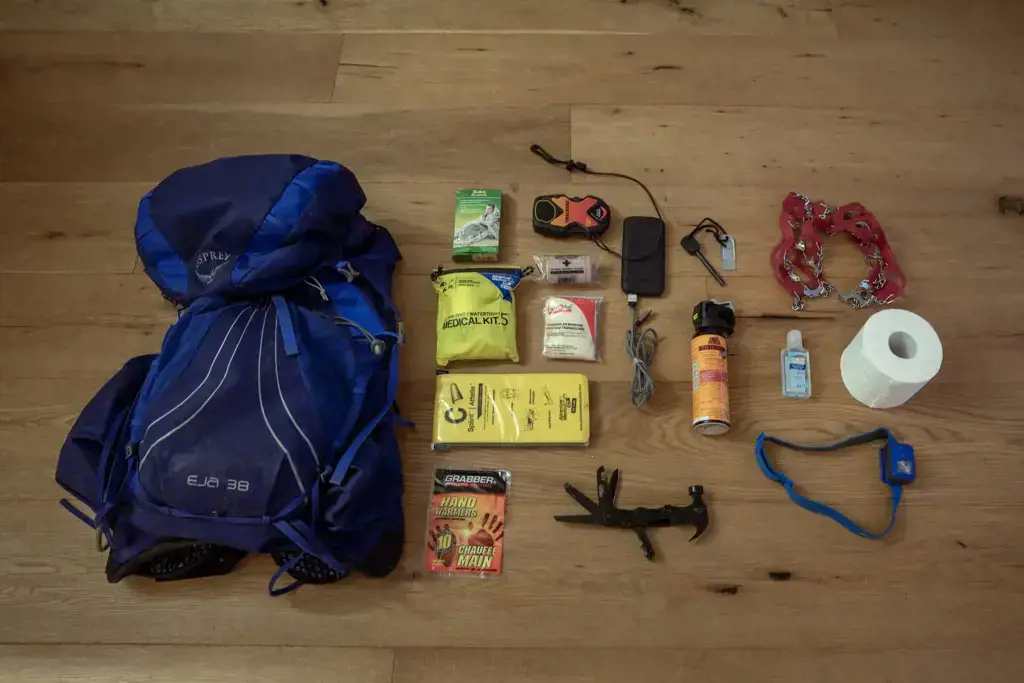
If you are planning a hiking trip to Banff, it is important to be prepared for any potential safety or emergency situations that may arise. Banff National Park is a beautiful and rugged wilderness area, but it can also pose certain risks, especially for those who are not familiar with the terrain or weather conditions. Here are some recommended safety and emergency items to bring with you on your hike to ensure a safe and enjoyable experience.
- Navigation Tools: A map and compass, or a GPS device, are essential for navigating the trails in Banff. Familiarize yourself with the route you will be taking and ensure you have the necessary tools to stay on track. It is also a good idea to download offline maps or trail apps on your phone, as a backup in case your primary navigation tools fail.
- First Aid Kit: A well-stocked first aid kit is a must-have item on any hiking trip. It should include bandages, antiseptic ointment, pain relievers, blister treatment, and any necessary prescription medications. Additionally, it is important to have a basic understanding of first aid procedures and wilderness medicine in case of injury or illness.
- Emergency Shelter: A lightweight emergency shelter, such as a bivy sack or emergency blanket, can provide much-needed protection from the elements in case of an unexpected overnight stay or extreme weather conditions. It is always better to be prepared for the worst-case scenario when venturing into the wilderness.
- Whistle and Signal Mirror: These small and lightweight items can be invaluable in attracting attention in case of an emergency. A whistle can be heard over long distances and can help rescuers locate you quickly. A signal mirror can be used to flash sunlight and catch the attention of passing aircraft or other hikers.
- Extra Food and Water: Always carry more food and water than you think you will need, especially on longer hikes or in remote areas. Pack lightweight, high-energy snacks such as nuts, dried fruits, and energy bars. Water purification tablets or a water filter can also come in handy in case you run out of drinking water and need to refill from natural sources.
- Emergency Communication Device: It is essential to have a reliable means of communication in case of an emergency. Cell phone coverage can be limited in the backcountry, so consider investing in a personal locator beacon (PLB) or satellite phone. These devices can send out a distress signal and help rescuers locate you quickly.
- Extra Clothing and Gear: Weather conditions in Banff can change rapidly, so it is important to be prepared for different scenarios. Pack extra layers of clothing, including a waterproof and windproof outer layer, to protect against rain, snow, and cold temperatures. Additionally, bring a headlamp or flashlight with extra batteries in case you get caught out after dark.
- Knowledge and Experience: Perhaps the most important safety item to bring with you on a hiking trip to Banff is knowledge and experience. Familiarize yourself with the local regulations, weather patterns, and potential hazards of the area. Take the time to learn basic wilderness skills, such as navigation, first aid, and how to start a fire. Consider taking a wilderness safety course or hiring a local guide if you are new to hiking or exploring unfamiliar terrain.
Remember, safety should always be your top priority when hiking in Banff. By being prepared and bringing the necessary safety and emergency items, you can enjoy the breathtaking scenery and outdoor adventures while minimizing the risks associated with wilderness travel.
Essential Packing Tips for Your Rocking Horse Ranch Getaway
You may want to see also

Are there any specific considerations or restrictions on what can be packed for a hiking trip to Banff?
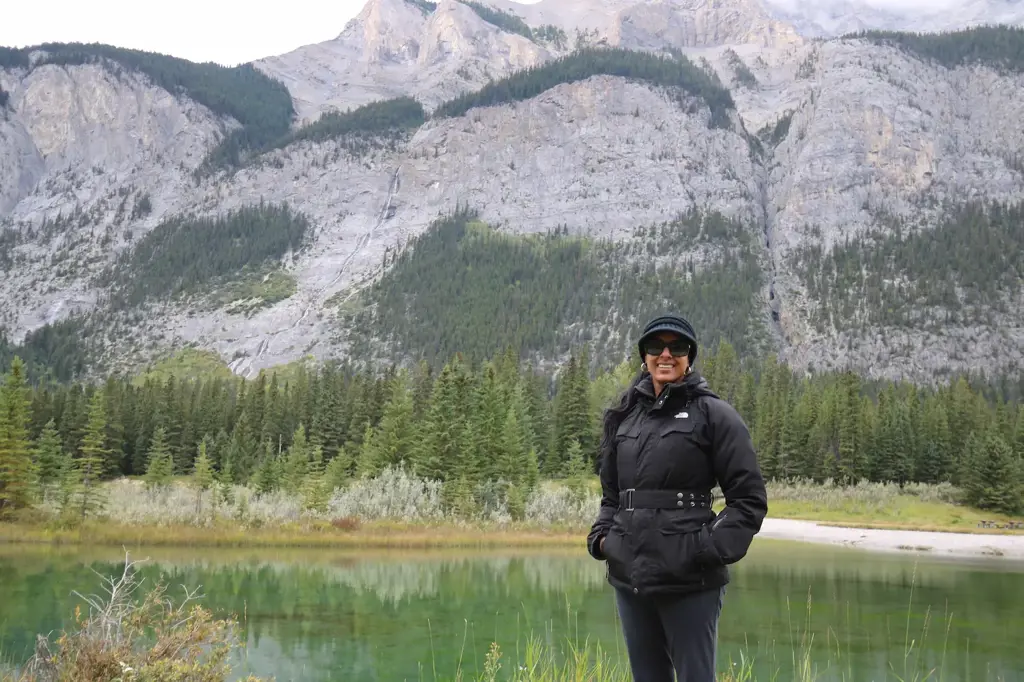
When packing for a hiking trip to Banff, there are a few considerations and restrictions to keep in mind. Banff National Park is located in Alberta, Canada, and is known for its stunning mountain scenery and diverse wildlife. To ensure a safe and enjoyable hiking experience, it's important to pack the right gear and follow any regulations that may be in place.
- Check the weather forecast: Before packing, make sure to check the weather forecast for Banff. The weather in the mountains can be unpredictable, and conditions can change rapidly. Pack clothing appropriate for the forecasted temperatures and conditions.
- Dress in layers: Layering your clothing is essential when hiking in Banff. This allows you to adjust your clothing to changing weather conditions and exertion levels. Start with a moisture-wicking base layer, add a insulating mid-layer, and finish with a waterproof and breathable outer layer. Hats, gloves, and warm socks are also important for keeping extremities warm.
- Pack essential hiking gear: Some essential hiking gear to pack for a trip to Banff includes a sturdy pair of hiking boots, a backpack to carry your supplies, a map and compass (or GPS), a whistle for emergencies, and a headlamp or flashlight. It's also important to bring a first aid kit with basic medical supplies and any necessary medications.
- Follow wildlife safety regulations: Banff National Park is home to a wide range of wildlife, including bears, elk, and mountain goats. It's important to follow any wildlife safety regulations that may be in place to protect both yourself and the animals. For example, bear spray is recommended and can be purchased or rented in Banff. Make sure to educate yourself on wildlife behavior and how to properly use bear spray before your trip.
- Leave no trace: When hiking in Banff, it's important to minimize your impact on the environment. Follow the principles of "Leave No Trace" by packing out all of your trash, staying on designated trails, and respecting wildlife and vegetation. It's also a good idea to bring a reusable water bottle and water purification system to minimize waste.
- Consider camping restrictions: If you plan on camping during your hiking trip, be aware of any camping restrictions that may be in place. Banff National Park has designated camping areas, and permits may be required for overnight stays. Make sure to research and obtain any necessary permits before your trip.
- Plan for emergencies: Finally, it's important to be prepared for emergencies when hiking in Banff. This includes carrying a well-stocked first aid kit, knowing how to navigate using a map and compass (or GPS), and letting someone know your itinerary before you set out. It's also a good idea to check in with park rangers or visitor centers for any updates on trail conditions or potential hazards.
In conclusion, when packing for a hiking trip to Banff, it's important to consider the weather forecast, dress in layers, pack essential hiking gear, follow wildlife safety regulations, leave no trace, consider camping restrictions, and plan for emergencies. By being prepared and following these guidelines, you can have a safe and enjoyable hiking experience in the beautiful Banff National Park.
The Essential Packing List for a Palau Vacation
You may want to see also
Frequently asked questions
When packing for a hiking trip to Banff, it is important to bring the essentials. This includes proper hiking boots, comfortable and breathable clothing, a hat, sunscreen, a backpack, a water bottle, and a first aid kit. It is also important to pack layers, as the weather in Banff can be unpredictable and temperatures can change quickly.
While basic hiking gear is sufficient for most trails in Banff, there are a few items that may be beneficial to pack. One of these is a bear spray, as encounters with wildlife, including bears, are possible. It is also a good idea to bring a hiking pole or trekking poles, especially for more challenging or steep trails. Additionally, a GPS or map and compass can be helpful for navigation.
It is important to dress appropriately when hiking in Banff. This means wearing moisture-wicking and breathable clothing, such as quick-drying shirts and pants. It is also important to pack layers, including a lightweight jacket or fleece for cooler temperatures. Additionally, it is recommended to wear a hat and sunglasses to protect against the sun, as well as sturdy and comfortable hiking boots to support your feet and ankles.



